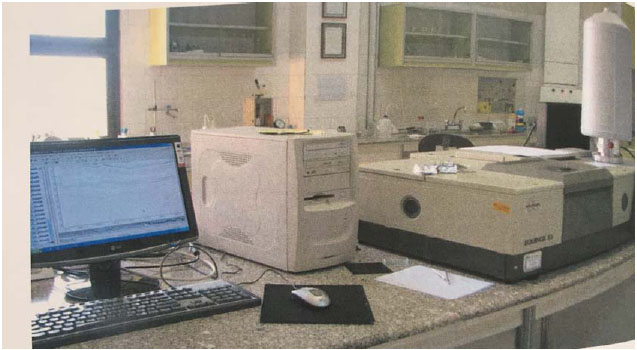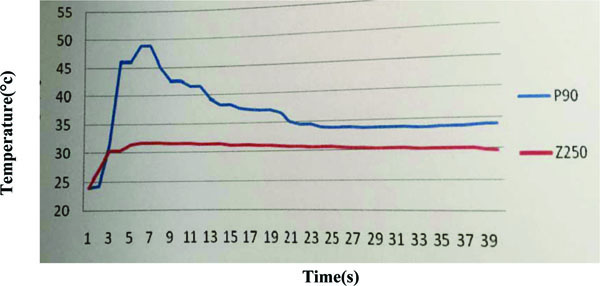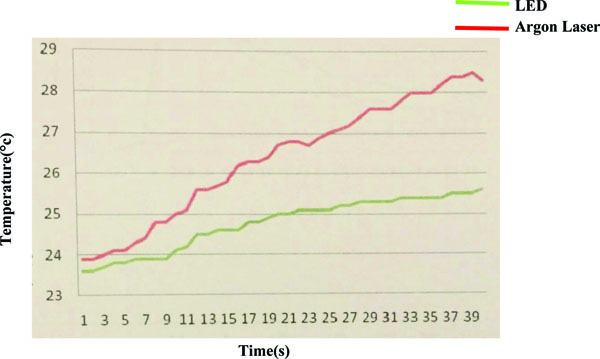All published articles of this journal are available on ScienceDirect.
Effect of LED and Argon Laser on Degree of Conversion and Temperature Rise of Hybrid and Low Shrinkage Composite Resins
Abstract
Objectives:
Different light curing units are used for polymerization of composite resins. The aim of this study was to evaluate the degree of conversion (DC) and temperature rise in hybrid and low shrinkage composite resins cured by LED and Argon Laser curing lights.
Materials and Methods:
DC was measured using FTIR spectroscopy. For measuring temperature rise, composite resin samples were placed in Teflon molds and cured from the top. The thermocouple under samples recorded the temperature rise. After initial radiation and specimens reaching the ambient temperature, reirradiation was done and temperature was recorded again. Both temperature rise and DC data submitted to one-way ANOVA and Tukey-HSD tests (5% significance).
Results:
The obtained results revealed that DC was not significantly different between the understudy composite resins or curing units. Low shrinkage composite resin showed a significantly higher temperature rise than hybrid composite resin. Argon laser caused the lowest temperature rise among the curing units.
Conclusion:
Energy density of light curing units was correlated with the DC. Type of composite resin and light curing unit had a significant effect on temperature rise due to polymerization and curing unit, respectively.
INTRODUCTION
Dental treatments often cause temperature rise in dental pulp. Heat may be generated by the application of different methods and materials such as rotary instruments and polymerization of dental composite resins [1, 2].
Composite resins are among the commonly used dental materials in restorative dentistry [3]. Recently, a generation of so-called low-shrink composites (silorane) has been introduced that promises a significant reduction in polymerization shrinkage [4]. Silorane resins are derivatives of siloxane and oxirane monomers composed of a hydrophobic siloxane backbone with oxirane rings. These monomers polymerize with a cationic ring opening and provide reduced shrinkage [5].
Light curing process is always associated with exothermic temperature rise which may be harmful to the dental pulp [6, 7].
Today, different light curing units (LCUs) are used in dentistry. Halogen curing light is among the most frequently used LCUs in dental offices [8]. In spite of the popularity of this curing light, it possesses some downfalls including the large difference between electrical input and light output, limited lifetime and high temperature generated by the filament that can damage the curing light bulb and cause pulp injuries as well [6, 9].
Another main dental curing light is the light-emitting diode (LED) that can polymerize light-cure resin-based composites generating much less heat [10] The efficacy of this device is due to the coordination of the light emitting spectrum with absorption spectrum of camphorquinone (CQ) in comparison with the broad spectrum in Halogen curing lights [11, 12]. Infra-red spectrum is not emitted by the LED in contrast to the Halogen LCUs. Longer lifetime and more stable output are among the advantages of LED curing lights. High powered LED is also available with an output equal to that of Halogen and can replace Halogen and LED curing lights [13].
Argon laser is another option for composite resin polymerization. It emits blue and green lights. Blue light can polymerize dental composite resins that have CQ as the photoinitiator [14]. Laser light has some characteristic features like being monochromatic and collimated and having selective absorption [15].
Degree of conversion (DC) is one of the most important factors in clinical performance of dental composite resins. Optimal physical, mechanical and biological properties of composite resins are related to a higher DC that per se is due to the total emitted light energy from the LCUs with proper wavelength in accordance with the photoinitiator of the composite resin [16]. Although higher light intensity causes higher DC resulting in better physical properties of the composite resin, it also generates more shrinkage stress that can lead to increased microleakage. Therefore, attempts must be made to minimize temperature rise and achieve an acceptable DC during composite resin polymerization in order to avoid any thermal damage to the pulp, achieve optimal properties of the restorative material and decrease shrinkage stress [17].
Therefore, the aim of this study was to investigate the temperature rise and DC of two types of composite resins (methacrylate based and silorane based) cured with different LCUs.
MATERIALS AND METHODS
In this experimental study, two LCUs were evaluated: Ultralume2 (Ultradent, USA) and Bluephase 16i (Ivoclar Vivadent, Lichtenstein). Argon laser (Melles, USA) was another curing light used in this study. Filtek Z250 (3M-ESPE) and Filtek P90 (3M-ESPE) shade A2 composite resins were selected. The characteristics of LCUs and composite resins are listed in Tables 1 and 2.
| LCUs | Manufacturer | LCU Type | Irradiation |
|---|---|---|---|
| Ultralume2 | Ultradent/USA | Diode | 40 s, 450 mw/s |
| Bluephase 16i | Ivoclar/Vivadent | High powered diode | 10 s, 1800 mw/s |
| Melles Griot | USA | Argon laser | 40 s, 500 mw/s |
| Composite Name |
Composite Type |
Resin | Filler Type |
Filler Size (µ) |
Filler Content (Volume) |
Filler Content (Weight) |
|---|---|---|---|---|---|---|
| Filtek P90 | Low shrinkage posterior restorative |
Silorane | Quartz, yttrium fluoride | 0.1-2 | 55% | 76% |
| Filtek Z250 | Hybrid | Bis-GMA, UDMA, Bis-EMA, TEGDMA |
Zirconia/ Silica | 0.01-3.5 | 60% | 78% |
Five samples were prepared for each combination of composite resin and LCU in Teflon molds with 4 mm diameter and 2 mm thickness. The top surface of samples was covered with celluloid strip with 0.3 mm thickness. Then, the light guide of the curing units was placed parallel to the sample surface in contact with the strip. Curing was done according to the manufacturer's instruction which was 40s for Ultralume2 and Argon laser and 10s for Bluephase16i. Temperature rise during the photopolymerization of the composite resin was measured and shown in monitor screen using a K-type thermocouple fixed under the specimens and connected to the thermometer (Fig. 1). Thermometer was able to measure the temperature rise as small as 0.1 ˚C. After initial curing and recording the degree of temperature rise, we waited for a couple of minutes until the specimens reached the ambient temperature which lasted for about 5 minutes. Samples were then re-irradiated through the cured composite resin and temperature was measured again. The temperature rise during the first radiation was due to both the heat from the exothermic polymerization and irradiation by the LCU; but in the second exposure, polymerization was already completed and the rise in temperature was predominantly due to the heat from irradiation. Thus, it was possible to measure the polymerization heat separately from the irradiation heat generated by the LCUs.

A thermocouple, a data logger and a computer were used for measuring and recording data. The thermocouple measured the sample’s temperature during the test and data logger processed data for saving in the computer.
For measurement of DC, a small amount of composite resin was placed between two polyethylene films that had no interference with the wavelengths absorbed by resins and was then pressed to form a very thin film and the absorbance peaks of uncured samples were quantified with FTIR (Equinox 55,Bruker, Germany) (Fig. 2). Afterwards, the peaks for cured samples were obtained. For each composite resin and LCU, 3 samples were prepared.

STATISTICAL ANALYSIS
The results were analyzed and compared using two-way ANOVA. Because of significant interaction between composite resins and curing unites, one-way ANOVA followed by the Tukey-HSD test at the significant level of 0.05 were done.
RESULTS
Initial temperature rise (T1) showed the total temperature rise due to the polymerization reaction and light irradiation by the LCU. T2 demonstrated the temperature rise due to the LCU and was measured by the re-irradiation of cured composite resin. The difference between these two temperatures indicated the temperature rise due to the polymerization reaction (T3). Time to reach maximum temperature rise was Tmax.
T1 was significantly different in various composite resins and LCUs. It was higher in P90 than in Z250 (p-value=0.001) and lower in laser than other curing lights. The two diode LCUs had no significant difference with each other in this regard (Graph 1).
T2 was not significantly different in various composite resins; but, it was significantly lower in laser LCU compared to other curing lights. The two diode LCUs had no significant difference with each other in this respect (Graph 2).


T3 was significantly different in various composite resins and was higher in P90 than in Z250, but no significant difference was found between different LCUs in this regard.
Tmax was not significantly different in various composite resins or different LCUs.
Mean values and standard deviations of T1, T2, T3 and Tmax are presented in Table 3.
| LCUs | Composite Brand |
T1 (°С) | T2 (°С) | T3 (°С) | Tmax (s) |
|---|---|---|---|---|---|
| LED | Filtek Z250 | 11.43 ± 0.83 | 7.88± 0.78 | 3.5 ± 0.77 | 7.7 ± 0.82 |
| Filtek P90 | 21.45± 2.02 | 7.86±0.78 | 13.59±1.83 | 8±1.05 | |
| High Powered LED |
Filtek Z250 | 11.81±1.49 | 7.72±0.72 | 4.09±1.51 | 4.4±0.52 |
| Filtek P90 | 26.25±1.75 | 7.62±1.02 | 18.63±2.24 | 4.3±0.48 | |
| Argon laser | Filtek Z250 | 7.86±0.95 | 3.41±0.36 | 4.45±0.93 | 8.4±0.96 |
| Filtek P90 | 13.12±1.7 | 3.17±0.35 | 9.95±1.87 | 9.7±1.15 |
DC was the same in different resin-based composites and LCUs. It means that neither the type of composite resin nor the LCU had any significant effect on DC. Mean values and standard deviations of samples’ DC are demonstrated in Table 4.
| LCUs | Composite | DC(%) |
|---|---|---|
| LED | Z250 | 53.40± 5.60 |
| P90 | 50.61 ± 4.02 | |
| High Powered LED | Z250 | 56.79 ± 4.86 |
| P90 | 55.30±4.72 | |
| Argon Laser | Z250 | 55.23±5.17 |
| P90 | 53.82±5.05 |
DISCUSSION
This study sought to assess the degree of conversion (DC) and temperature rise in two different dental composite resins: Filtek Z250 and Filtek P90 using LED and argon laser LCUs. Neither the type of composite resin nor the curing light had any significant effect on DC at the surface. Both composite resins reached an acceptable DC through radiation with different curing lights. The DC depends on total light energy, duration of radiation, photon wavelength and composite resin composition. The similar energy density of different light sources is responsible for similar DC at the surface of composite resin samples [18].
Our findings are similar to those reported by Rostelli in 2008. In his study, argon laser and LED curing lights had no statistically significant difference in terms of temperature rise and DC in Z250 composite resin. This similarity was claimed to be due to the equal energy density of both light sources [19].
In another study by Pallin in 2005, the DC of two methacrylate-based composite resins Z250 and Z100 and two experimental silorane-based composite resins H1 and EXL was measured. It was found that the DC of methacrylate-based composite resins in about 0.1 hour was higher than that of silorane-based composite resins. However, after 24 to 48 hours, the DC of methacrylate-based composite resins did not increase as fast as that of silorane-based composite resins. He attributed this difference to the kinetics of cationic polymerization reaction of oxirane in comparison to methacrylate-based composite resins which had a high volume of free monomers due to the greater movement of polymeric chains in time resulting in subsequent increase in DC [20].
In the mentioned study, the DC was measured shortly after the curing and was found to be the same in both composite resins. If the DC had been measured at the time intervals, different results might have been obtained.
Rostelli measured the DC at different time intervals and observed no significant difference between LED and argon laser at different depths. Hence, for both curing lights, the polymerization was sufficient up to 2mm thickness and the DC of Z250 composite resin samples was adequate. However, polymerization was insufficient in areas deeper than 2mm [19].
In the present study, for all the curing units, type of composite resin did have a significant effect on overall (T1) and polymerization temperature rise, but had no effect on the temperature rise due to the curing units.
The overall (T1) and polymerization temperature rise in silorane-based composite resins (P90) can be due to the ring-opening cationic reaction of oxirane and siloxane molecules. This reaction takes place in oxirane molecule [21]. Optical pyrometry studies show that the cationic ring-opening polymerization reaction is an exothermic reaction that increases the temperature up to 100 degrees above the room temperature. Also, the amount of generated heat by the cationic polymerization is related directly to the number of photoinitiators [22]. This finding is in accord with the results of Vesna Miletic study in 2009 who measured the temperature rise due to silorane, ormocer and methacrylate-based composite resin polymerization.
P90 (Siolrane- based dental composite resin) showed higher temperature rise than Amira (Ormocer) and Herculite XRV (Methacrylate-based dental composite resin). No difference was found between the last two in terms of temperature rise when a high powered LED curing unit (Blue Phase) was used with a curing time of 20 seconds [23].
In none of the curing units, the type of composite resin had any effect on the temperature rise due to the light source (T2). This finding seems acceptably logical because T2 is the temperature rise measured after the polymerization of composite resin and it only reflects the heat generated based on the type of curing light. When T2 is measured, most of the composite polymerization process has already taken place and the generated heat dissipates as the samples reach the ambient temperature. Thus, T2 was not affected by the type of composite resin or heat due to polymerization.
These findings are in accordance with those of Khezevic study in 2005. Second irradiation of the cured samples for 20 s caused similar temperature rise in all modes of radiation with no significant difference [24].
Our findings however, were not in agreement with those of Tabatabaei et al, in 2009, who demonstrated that the temperature rise due to the curing units was influenced by the type of composite resin. They used Filtek Supreme (Nanofill) and Tetric Ceram (Hybrid) composite resins in their study which were different from ours. Their finding may be attributed to the difference in opacity and scattering of the light passing through the composite resin used by them [25]. Considering the results of the current study, it seemed that the two composite resins, P90 and Z250 acted similarly in terms of light scattering and transmission.
The curing process of composite resin samples results in their temperature rise. Tmax is a time point at which composite resin samples reach their maximum temperature during the curing phase. It provides information about the pre-gel stage. Gel-point is an important point in composite resin polymerization process, because it can compensate polymerization stress. Thus, Tmax can be related to vitrification stage of dental composite resins.
In none of the LCUs, the composite resin had any significant effect on Tmax. In both types of composite resins with all the LCUs, maximum temperature rise occurred during the first seconds of irradiation and then dropped.
This finding is in accord with the results of Knezevic study in 2005, who reported that maximum temperature rise occurred in the first few seconds of irradiation [23]. Pilo and Sakaguchi reported that during the first 20 or 30 seconds of radiation, temperature rise reaches its highest value and then becomes steady [26, 27].
In Tabatabie’s study, type of composite resin played a significant role in reaching the maximum temperature during the curing process. That is to say, it took longer for Filtek Supreme (Nanofill composite resin) to reach its maximum temperature as compared with Tetric Ceram(Hybrid).This can be explained by the slower polymerization process of Filtek Supreme due to the smaller size of nanofillers and higher effective surface. Therefore, as the polymerization rate slows down, it takes longer for the temperature to reach its maximum level [25].
CONCLUSION
The degree of conversion and temperature rise by the use of High Powered LED, LED and Argon laser curing lights were analyzed in P90 and Z250 composite resins. The obtained results were as follows:
- 1- In both composite resins, Argon laser caused the lowest temperature rise compared to others while LEDs showed the highest rise in temperature.
- 2- For all three curing units, P90 showed significantly higher temperature rise compared to Z250. Thus, type of composite resin has a considerable effect on the temperature rise.
- 3- No difference was found between P90 and Z250 in terms of the degree of conversion with all the curing units.
- 4- The LEDs caused higher temperature rise than Argon laser, but with no improvement in the polymerization process.
CONFLICT OF INTEREST
The authors confirm that this article content has no conflict of interest.
ACKNOWLEDGEMENTS
Declared none.


